Chores to Do Before Real Winter Arrives
Posted on Tuesday, December 15, 2020 · Leave a Comment
Our gardens are put to bed for the winter: veggie stalks are pulled and composted, perennials are cut back, weeds pulled, leaves raked. Everything is a snug as a bug in a rug. But I’m not done quite yet – and you might have a few chores to do before deep snow arrives, too.
Young trees, especially young fruit trees, are often targeted by voles in winter. If they chew all the way around a tree, removing bark and the cambium layer beneath it, they will die. This is called girdling and happens most often in winters with deep snow because rodents live beneath the snow and are less likely to be caught by owls or other predators.
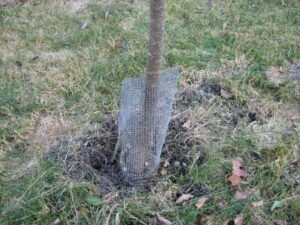
Hardware cloth to protect apple tree from voles
To prevent girdling, you need only surround young trees with a protective shield of “hardware cloth” made with quarter-inch wire mesh. It is sold at hardware stores and comes in rolls of various widths. I use 24-inch wide hardware cloth and cut it with tin snips. It is too tough to cut with scissors. I cut pieces that will go around the trunk and overlap a little, and tie it with wire or string. I squeeze the top after encircling the trunk so that no ambitious mice can drop down from the opening.
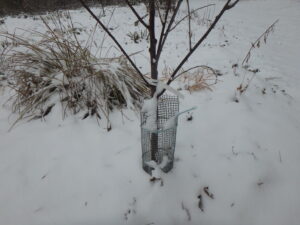
Hardware cloth will keep rodents from chewing the bark and killing this young cherry tree
Another rodent-related task is to protect my riding lawn mower from mice that want to spend the winter inside the air filter. They have done that in the past, causing problems. Now? I just put a few moth balls in a sock, lift the hood, and lay it inside. It keeps away the mice.
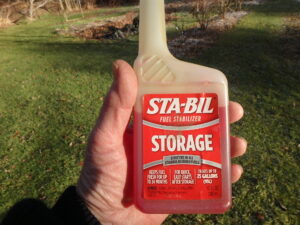
Fuel stabilizer will save headaches in the spring
I have already winterized my mower. This means I added something to prevent the gas from going flat during the months of non-use. I use a product called Sta-Bil. Add it to the gas, then run the engine for 5 minutes. Come spring, my mower starts right up.
I find that it is useful now, in the fall, to go outside with a clipboard and pencil to draw this year’s vegetable garden. Yes, the garden is all cleaned up, but I still remember exactly where everything was. Come spring I might not remember just exactly where the leaks or beans were.
I use wide raised beds for my veggies, and leave them in place from year to year. It is good to pick a new spot each year to plant the regulars – tomatoes, potatoes, squash, etc. I like to rotate plantings so that insects and diseases are less likely to find their favorites. Rotation doesn’t stop diseases or pests, but it makes sense to minimize them by moving crops from year to year. In small gardens, this is almost a futile effort and even in large gardens you will have tomato diseases each year no matter what you do.
I don’t believe in pampering my plants. They have to make it on their own, without too much fussing from me. So I have never been one to build shelters over shrubs to shelter them from cold winds or ice falling off the roof. I don’t plant shrubs beneath the drip line of the house.
This year I got a small cut leaf Japanese red maple and planted it about 10 feet from the drip line of my house. It was a perfect planting spot except for one thing: when the relatively flat roof of the house is shoveled after a foot or more of snow, the ice and snow could land on it – after a 30 foot drop. Yikes. I decided to build a simple shelter for it, as I had spent $125 on the tree and don’t want it broken.
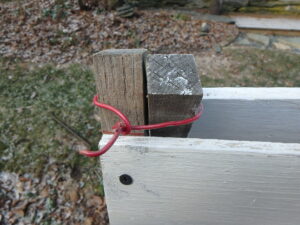
Wire the 2 sides of the A-frame together
Here is what I did: I got four 5-foot long wooden grade stakes and a piece of half-inch plywood. I had a scrap of plywood 60 inches by 40 inches, and cut it in half to create two pieces 30 by 40 inches. I painted the plywood to keep it from delaminating, and then screwed the plywood to the stakes. I left two inches of each stake clear at the top before attaching the plywood, and drilled holes sideways through them.
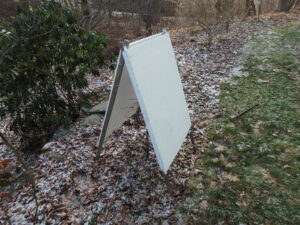
A simple plywood A-frame will protect a shrub from snow and ice coming off the roof
To set up the shelter, I pushed the bottom of the stakes into the soil at an angle, meeting in the middle over the small tree. Then I tied them together with a strand of copper wire going through the holes I had drilled in the stakes. It seems sturdy, and strong enough to deflect any snow pushed off the roof.
I have a number of hand tools with wooden handles that are 50 to 75 years old, tools that my parents and grandfather used and that were passed on to me. I treasure them. To keep them in good condition, I clean and oil those wooded handles in the fall, and recommend you do yours, too.
First, I wipe off any soil from handles and blades. Blades get brushed with a wire brush if needed. Handles get a quick touch up with fine steel wool or sand paper if there are rough spots. Then everything gets wiped down with rag moistened with boiled linseed oil. That oil is available at hardware stores – even in this day of fiberglass handles, which don’t need treatment. The oil on metal parts will minimize rusting. Motor oil would work, but I don’t want it going in the soil next spring.
An old saying goes, “A woman’s work is never done.” That’s true for gardeners of both genders. I’m sure I will find something else to do before deep snow flies that is not on my list. Meanwhile, I can dream of finding time to read good books by the wood stove.
Henry’s book,
Organic Gardening (not just) in the Northeast, has sold out. A second printing is underway, but some orders will not be shipped until after Christmas. You may e-mail Henry to check on the status of your order at
henry.homeyer@comcast.net.







